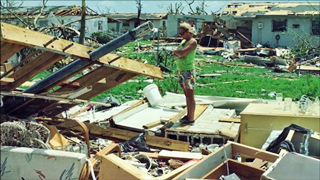|
How to keep your home, and what's inside it,
safe |
Article Courtesy of The Sun Sentinel
By Brett
Clarkson
Published
May 30, 2018
With a hurricane bearing down, thereís no question
youíll want to keep you and your family safe, not to mention your house
Ė and whatís inside it.
Here is how you can do that.
Openings: If your house doesnít have shutters
or impact resistant windows, cover them with plywood. Garage doors
should be reinforced from the inside, with wood studs or metal braces
attached lengthwise.
|
The roof: Repair cracked or
missing roof tiles or loose shingles. Inspect and replace
any boards along the roof edges that show signs of decay.
Check the hurricane straps, which hold the roof frame to the
walls of the house, for any loose, rusting, or missing
straps. Replace or repair any trusses or beams that have
cracks, large knots or insect damage. To make temporary
repairs, nail 8-foot-long (or longer) 2-by-4s on both sides
of the damaged truss or beam.
Outside the house: Trim trees and shrubs, cut limbs
or trees that could fall against the house. (Tree removal
should be done well in advance, as you may need approval
from your municipality.) Move inside anything that could
become airborne in high winds. Move vehicles inside the
garage, or away from where trees could potentially fall. If
you have a boat, secure it, or place it in a safe harbor or
at a marina or dock.
Safe room, in-home shelter: A safe room is a
reinforced area inside your home, although it can also be
built as an outside addition. It should have running water,
a toilet and allow at least 10 square feet per person. Safe
rooms shouldnít be built in evacuation zones because they
they wouldnít protect against rising water. If you donít
have a reinforced in-home shelter, everybody in the home
should go into the strongest interior room, preferably one
without windows. For more information, check out
www.fema.gov and
www.floridadisaster.org.
|
|
The Sun Sentinel takes a look at some of South
Florida's worst hurricanes, as well as ways to weather the storm.
WATCH VIDEO
|
Guns: Make sure all firearms are stored and
locked in a safe that protects against flood and fire damage.
Jewelry: Store in a flood-proof safe, or if possible, in another
location such as a bank safety deposit box.
Important documents: If youíre evacuating, take along all
important documents such as insurance policies, mortgage statements,
birth certificates, social security cards, and passports. If you remain
at home, keep them at the very least in a Ziplock bag or a sealed,
waterproof container. If you have a flood-proof safe, put the documents
in there.
Computers and cellphones: Save important files on your computer
to a cloud service. Make sure any computers or devices are stored in a
place where they are less likely to be damaged by floodwaters. Unplug
any devices and remove any cords or cables from the floor. With
cellphones, write down each important phone number that you may need in
case cell service or the ability to charge a phone with a dead battery
isnít available.
Propane tanks: Never store a propane tank indoors, not even in
the garage. Store it outside, ensuring itís secured so that it doesnít
become a projectile in the stormís winds.
|
